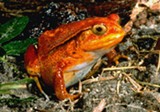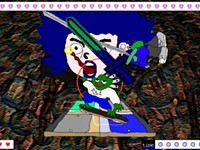[
{
"name": "500x250 Ad",
"insertPoint": "5",
"component": "15667920",
"parentWrapperClass": "",
"requiredCountToDisplay": "1"
}
]
A new travelling exhibit that opened today at Rochester Museum and Science Center offers visitors the chance to explore the immense biological variation within just one order of animals. "Frogs: A Chorus of Colors" features more than 90 live individual animals from 16 different species (of the amazing 5,400 species found on Earth).
Dan Menelly, chief program officer for science and technology at RMSC, saw the exhibition at the Royal Botanical Gardens in Canada, and was excited to bring it to Rochester. "To experience so many frog species from around the world up close and in such fine detail is incredibly rare," he says.
Within the exhibition, frogs' biological features, natural history, role in human cultures, importance to global ecosystems, and their vulnerability within changing environments are all on display. Species on exhibit include tree frogs, the Chinese gliding frog, the American bullfrog, the "tomato" frog, jewel-toned poison dart frogs, and a variety of horned frogs, among others.
In addition to the 16 species (from such diverse environments as tropical forests, the frozen tundra, and scorching deserts), which are showcased in carefully-balanced habitat tanks, the exhibit mixes in items from RMSC's own vast collection. These includes a totem pole and a quiver to hold blowgun darts, as well as specimens of animals that are natural predators or prey to frogs.
"Object-based learning is so compelling for kids," Menelly says. "Schools are looking to make science and history as engaging as they can, and they have this common core initiative. They have so much to do with the kids, I think museums have a special opportunity to partner with the teachers and help them make the learning as visual and exciting as it can be."
Meet the African Bullfrog from CITY Newspaper on Vimeo.
A sound station allows visitors to create a chorus of croaks, peeps, ribbits, and other calls. At another console, visitors can perform a virtual dissection. Display cases hold examples of frog skeletons, from fragile specimens that might fit in the palm of your hand, to the hardy Goliath frog, which would sit comfortably in your lap. In another case, a model of a human skeleton is showcased with that of a few frog species, to compare and contrast biological features. "See how the bones are fused?" Menelly asks, pointing to a frog leg. "It allows them to jump long distances."
In a sunlit alcove off to one side of the exhibit, a lily pad-like lounging area is stocked with frog puppets and storybooks. A staged area will serve as a space for lessons with kids using animals from RMSC's own collection (the institution's Inquiry Room has about 21 different specimens, including turtles, and frogs, and toads). Merging the traveling exhibition with journaling and up-close study is meant to create a more in-the-field kind of experience for young learners.
The exhibit showcases how traits that kept individual frogs alive -- slippery skin, camouflage, mimicry, or toxic secretions -- were passed on within species and became defining features. Visitors can examine the stages of metamorphosis, and learn to identify the differences between frogs and toads.
RMSC is also working with Jacques Robert of the University of Rochester, who does research on virus transmission in the African water frog through the exotic pet trade. He'll lecture on his research and curate content for RMSC's "Science on A Sphere" feature. Watch the museum's site for updates and scheduling.
The show also includes information on frogs as "bellwether" species: ecological indicators regarding the health of the environment. Some of the information included in the exhibit links to The Citizen Science movement, which encourages everyday people to get involved with conservation. You can find out more at zooniverse.org, scistarter.com, or citizensciencealliance.org.
While the main targeted age group is elementary and middle school kids, the exhibit should be fascinating to people of all ages. As Menelly and I walked through the exhibit, we shared memories of catching tadpoles and frogs as children. It's easy to see how even adults may recall that sense of childlike wonder about the natural world.
"We are excited to provide the Rochester community with this excellent opportunity to explore the stories of some of the most visually stunning and adaptively remarkable life forms on Earth," he says. "We're hoping that people will visit and have some personal connection. We want people to wander and imagine, and remember their own personal experiences."
Special live animal shows will take place every weekend during the exhibition's run in the Riedman Gallery. The Wildlife Defenders will present live animals and also discuss environmental and wildlife conservation at 12:30 p.m. and 2:30 p.m. every Saturday and Sunday through January 10. The animals in attendance may include Eastern Grey Kangaroo, African Crested Porcupine, and South American Marine Toads, among others. Additional presentations will be held during select school breaks and special events.
Speaking of...
-

Where to celebrate Saturday’s partial eclipse
Oct 13, 2023 -

Midwinter family activities to cure cabin fever
Feb 25, 2022 -

It's gut check time at FLX Fermentation Festival this weekend
Aug 12, 2021 - More »
Latest in Culture
More by Rebecca Rafferty
-

Beyond folklore
Apr 4, 2024 -

Partnership perks: Public Provisions @ Flour City Bread
Feb 24, 2024 -

Raison d’Art
Feb 19, 2024 - More »



